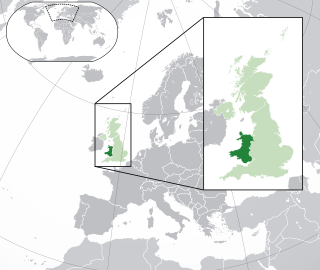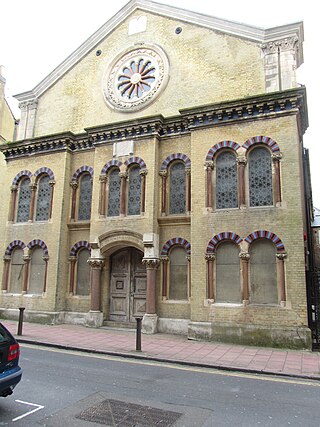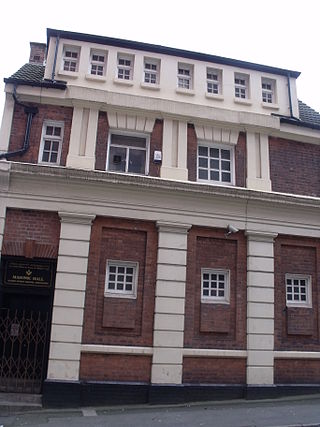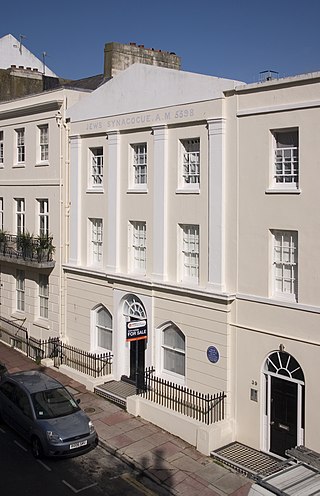
Merthyr Tydfil is the main town in Merthyr Tydfil County Borough, Wales, administered by Merthyr Tydfil County Borough Council. It is about 23 miles (37 km) north of Cardiff. Often called just Merthyr, it is said to be named after Tydfil, daughter of King Brychan of Brycheiniog, who according to legend was slain at Merthyr by pagans about 480 CE. Merthyr generally means "martyr" in modern Welsh, but here closer to the Latin martyrium: a place of worship built over a martyr's relics. Similar place names in south Wales are Merthyr Cynog, Merthyr Dyfan and Merthyr Mawr.

The River Taff is a river in Wales. It rises as two rivers in the Brecon Beacons; the Taf Fechan and the Taf Fawr before becoming one just north of Merthyr Tydfil. Its confluence with the River Severn estuary is in Cardiff.

The Great Synagogue of London was a former Orthodox Jewish congregation and synagogue, located in the City of London, England, in the United Kingdom. The synagogue was, for centuries, the centre of Ashkenazi life in London. Built north of Aldgate in the 17th century, it was destroyed during World War II, in the Blitz.

The New West End Synagogue is an Orthodox Jewish congregation and synagogue, located in St. Petersburgh Place, Bayswater, in the City of Westminster, London, England, in the United Kingdom. The congregation has been a member of United Synagogue since 1879.

The history of the Jews in Wales begins in the 13th century. However, after the English conquest of Wales (1287–1283), Edward I issued the 1290 Edict of Expulsion expelling the Jews from England. From then until the formal return of the Jews to England in 1655, there is only one mention of Jews on Welsh soil.
The Torah Temimah Primary School, located in the former Dollis Hill Synagogue, is a one form entry Voluntary Aided maintained primary school in the London Borough of Brent. It is a strictly Orthodox Jewish single-sex primary school for up to 204 boys aged 3–11. The school includes a Nursery.

Heaton Park Hebrew Congregation is a large Ashkenazi Orthodox synagogue located in North Manchester, United Kingdom. It was founded in 1935, and in 2010 had between 500 and 749 members. Under the aegis of the Chief Rabbi of the United Kingdom, Reverend Leslie Olsberg MBE led the congregation for 35 years until his death in 2008. Rabbi Daniel Walker succeeded him, and currently heads the congregation. Yehuda Marx is the hazzan.

Guildford Synagogue refers both to a probably medieval synagogue and to a modern congregation in Guildford, Surrey, England.

The Middle Street Synagogue is a synagogue in the centre of Brighton, part of the English city of Brighton and Hove. It was the centre for Jewish worship in Brighton and Hove for more than a century. Although it is not in full-time use, the building is still open at certain times, and cultural events frequently take place, as do weddings. It has been listed at Grade II*, reflecting its architectural and historic importance.

The Sunderland Synagogue is a former Orthodox Jewish congregation and synagogue, located on Ryhope Road, in Sunderland, Tyne and Wear, England, in the United Kingdom. The congregation was formed as the Sunderland Hebrew Congregation in 1861 and worshiped in the Ashkenazi rite until the congregation was dissolved in 2006.

Jesmond Synagogue, now known as Byzantine House, is a former Orthodox Jewish congregation and synagogue, located on Eskdale Terrace, in the Jesmond neighbourhood of Newcastle upon Tyne, in northeast England, in the United Kingdom. Established in 1914, the congregation worshiped in the Ashkenazi rite, until its closure in 1986.

The Cheltenham Synagogue is a synagogue in Cheltenham and is noted for its Regency architecture. It is an independent congregation located in the town centre on Synagogue Lane, off St James's Square.

The Severn Street Synagogue is a former Orthodox Jewish congregation and synagogue, located at 60 Severn Street, Birmingham, West Midlands, England, in the United Kingdom. The congregation was founded in 1809 and worshiped in the Ashkenazi rite until the congregation was merged into the Singers Hill Synagogue congregation in 1856.

The Plymouth Synagogue is a synagogue in the city of Plymouth, England and the home of the Plymouth Hebrew Congregation. Built in 1762, it is a listed Grade II* building and the oldest extant synagogue built by Ashkenazi Jews in the English speaking world.

The Brighton Regency Synagogue, also called the Devonshire Place Synagogue, is a former Orthodox Jewish congregation and synagogue, located at 38–39 Devonshire Place, Kemptown, Brighton and Hove, in East Sussex, England, in the United Kingdom. The congregation, established in 1824, worshiped in the Ashkenazi rite.

Sandy's Row Synagogue is an Orthodox Jewish congregation and synagogue, located on Sandys Row, on the corner of Middlesex Street in Bishopsgate, in the East End, Borough of Tower Hamlets, London, England, in the United Kingdom.

Synagogues may be considered "oldest" based on different criteria. A number of synagogues that predate the expulsion of the Jews from England have been discovered by archaeologists or by historians in buildings that have been in use for other purposes for many centuries. A second set of synagogues post-dates the legal return of Jews to England in the seventeenth century. Some synagogues have been destroyed or demolished and rebuilt on the same site, so that, while the site or congregation may be very old, the building may be modern. Still other old synagogue buildings exist, but were sold by the congregation and are now used for other purposes, some as churches or mosques, others for everything from residences to school recital halls. And some very old synagogues have been in continuous use as synagogues for many centuries.

Cefn-coed-y-cymmer is a small community on the northwestern edge of Merthyr Tydfil County Borough in Wales. It is situated in the neck of land between the rivers Taf Fawr and Taf Fechan at their confluence. The village lies within the community of Vaynor. Immediately to the north of the village is the hill of Cefn Cil Sanws on the southern slopes of which is Merthyr Tydfil Golf Club. The village is bounded both to the north and the west by the Brecon Beacons National Park.

Merthyr Tydfil Town Hall is a municipal building in the High Street, Merthyr Tydfil, South Wales. The town hall, which was the headquarters of Merthyr Tydfil County Borough Council, is a Grade II* listed building.


















